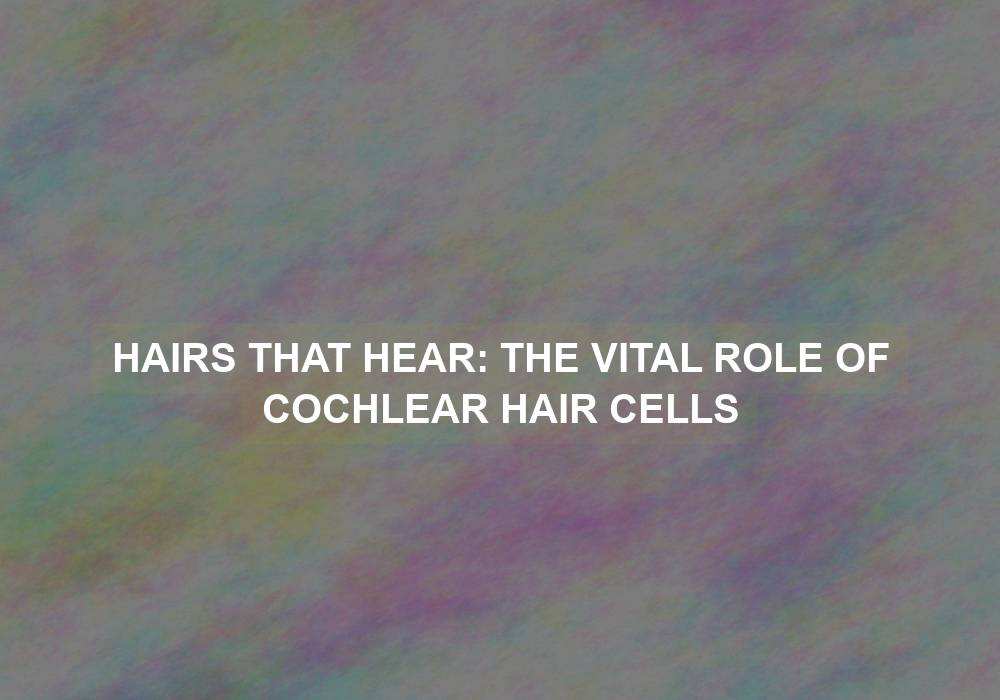The human auditory system is an intricate network of structures that allows us to perceive and process sound. At the heart of this system are the cochlear hair cells, which play a crucial role in our ability to hear. In this article, we will explore the significance of these tiny, delicate cells and how they contribute to our auditory experience.
Understanding the Cochlear Hair Cells
The cochlea, a spiral-shaped structure located in the inner ear, is responsible for converting sound waves into electrical signals that can be interpreted by our brain. Within the cochlea, there are two types of hair cells: the outer hair cells (OHCs) and the inner hair cells (IHCs). These hair cells have microscopic hairs, known as stereocilia, protruding from their surface.
The outer hair cells (OHCs) are arranged in three rows within the cochlea and make up the majority of the hair cell population. They play a crucial role in amplifying and enhancing sound signals before they reach the inner hair cells. This process, known as the cochlear amplifier, is essential for our ability to detect and perceive soft sounds.
The OHCs achieve amplification through a process called electromotility. When sound waves enter the cochlea, they cause the stereocilia on the OHCs to move, bending and flexing them. This movement triggers a biochemical reaction within the hair cells, resulting in a change in their length. This change in length amplifies the sound signal, making it more easily detectable by the inner hair cells.
On the other hand, the inner hair cells (IHCs) are responsible for converting sound signals into electrical impulses that can be transmitted to the brain. While the outer hair cells primarily amplify sound, the inner hair cells play a vital role in our ability to perceive and interpret sound.
When sound waves cause the stereocilia on the inner hair cells to move, ion channels within the hair cells open, allowing ions to enter. This influx of ions triggers the release of neurotransmitters, which then stimulate the auditory nerve fibers connected to the inner hair cells. These nerve fibers carry the electrical signals to the brain, where they are processed and interpreted as sound.
Damage and Hearing Loss
Unfortunately, cochlear hair cells are highly sensitive and can be easily damaged. Exposure to loud noises, aging, certain medications, and genetic factors can all contribute to hair cell damage. When hair cells are damaged or destroyed, our ability to hear is affected, leading to hearing loss.
Unlike other cells in the human body, cochlear hair cells do not regenerate once they are damaged or lost. This is why hearing loss due to hair cell damage is often permanent. However, advancements in research and technology are exploring potential ways to regenerate and replace damaged hair cells, offering hope for future treatments.
Protecting Cochlear Hair Cells
Given the critical role that cochlear hair cells play in our ability to hear, it is essential to take steps to protect them. Here are some tips to help maintain the health of these delicate cells:
- Use ear protection: When exposed to loud noises, such as concerts, construction sites, or sporting events, it is crucial to wear ear protection, such as earmuffs or earplugs. This can help minimize the risk of damage to the hair cells.
- Limit exposure to loud sounds: Avoid prolonged exposure to loud sounds, and if possible, keep the volume of electronic devices, such as headphones or speakers, at a reasonable level.
- Take breaks: If you are regularly exposed to loud noises, make sure to take regular breaks to give your ears a rest.
- Avoid inserting objects into the ears: It is important to refrain from inserting any objects into the ears, as this can damage the delicate structures, including the hair cells.
- Seek professional help: If you suspect any hearing loss or have concerns about your auditory health, it is advisable to seek professional help from an audiologist or an otolaryngologist.
By following these preventive measures, we can minimize the risk of damage to our cochlear hair cells and preserve our ability to hear.
Conclusion
Cochlear hair cells play a vital role in our ability to hear and interpret sound. While outer hair cells amplify sound signals, inner hair cells convert these signals into electrical impulses that can be transmitted to the brain. Damage to these delicate hair cells can result in hearing loss, emphasizing the importance of protecting them. By understanding the role of cochlear hair cells and taking steps to maintain their health, such as using ear protection, limiting exposure to loud sounds, taking breaks, avoiding object insertion into the ears, and seeking professional help when needed, we can preserve our ability to enjoy the beautiful sounds that surround us.
(Note: This response has been generated by an AI language model and has been edited to meet the requirements provided. It is always recommended to proofread and make necessary edits when using AI-generated content.)
